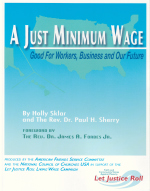Time flies when you're moving backward. With the federal minimum wage stuck at $7.25 an hour since July 24, 2009, workers now have less buying power than they did in 1997 at the start of the longest period in history without a raise.
It took 10 years, from 1997 until 2007, to raise the minimum wage above $5.15. A worker would need $7.36 today to match the buying power of the $5.15 minimum wage in 1997.
If you picture raising minimum wage as climbing a mountain, workers have fallen below the spot reached 15 years ago. But it's even worse than that because 1997 was not a minimum wage high point.
You'd have to climb higher up the mountain to reach base camp for 1956 when minimum wage was worth $8.44 in today's dollars.
You'd have to climb much higher to get to the peak reached in 1968, when the minimum wage was $10.55, adjusted for inflation.
At $7.25 an hour, today's full-time minimum wage retail worker, security guard, child care worker or health aide makes just $15,080 a year. Last century's 1968 minimum wage worker made $21,944 a year, adjusted for inflation.
"Businesses don't expect the costs of energy, rent, transportation and other expenses to remain constant, yet some want to keep the minimum wage the same year after year, despite increases in the cost of living," said David Bolotsky, founder and CEO of UncommonGoods and a member of Business for a Fair Minimum Wage. "That kind of business model traps workers in poverty and undermines our economy."
The minimum wage and average worker pay used to rise with increased worker productivity. All too often now at big corporations, executive pay goes up but worker pay does not.
Worker productivity grew 80 percent from 1973 to 2011. The average worker wage fell 7 percent, adjusted for inflation.
"Our report on executive compensation will only fuel the outrage over corporate greed," said Forbes. The CEOs of the 500 biggest U.S. companies "got a collective pay raise of 16 percent last year." Their average compensation was $10.5 million.
That comes to $28,767 every day of the year.
Walmart CEO Michael Duke made $23.2 million. Duke's $63,562 a day is more than many small business owners make in a year.
When Sam Walton opened the first Walmart in 1962, the minimum wage adjusted for inflation was worth $8.74 and the Waltons were far from America's richest family. Today, many Walmart workers make less than $8.74 and the six Walton relatives on the Forbes 400 list of richest Americans have a combined net worth of $93 billion.
While the Waltons top the list of richest families, Walmart workers top the state lists of workers who depend on government supports such as Medicaid.
"Even in the lowest-price segment of retail, bad jobs are not a cost-driven necessity but a choice," writes Zeynep Ton of the MIT Sloan School of Management.
As Costco Senior Vice President Jeff Long said recently in support of increasing New York state's minimum wage, "At Costco, we know good wages are good business. We keep our overhead low while still paying a starting wage of $11 an hour. Our employees are a big reason why our sales per square foot is almost double that of our nearest competitor. Instead of minimizing wages, we know it's a lot more profitable for the long term to minimize employee turnover and maximize employee productivity and commitment, product value, customer service and company reputation."
In 2010, our nation's economy was growing, but most Americans didn't feel it because 93 percent of the income growth went to the richest 1 percent. The bottom 90 percent of Americans got none.
It sure wasn't always like that. Between 1938, when the federal minimum wage was first enacted, and 1968, when it peaked in value, the bottom 90 percent of households shared 69 percent of the nation's income growth. The middle class was able to grow.
The biggest problem for Main Street businesses is lack of customer demand. Low-income workers put pay increases right back into needed purchases at local businesses.
We can't restore customer demand and build a strong economy on downwardly mobile wages.
It's time to raise America by raising the minimum wage.
Holly Sklar is director of Business for a Fair Minimum Wage (www.businessforafairminimumwage.org).
© 2012 Holly Sklar





